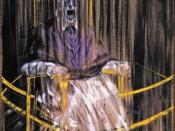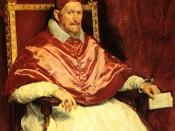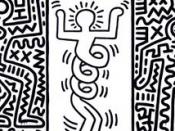There are many contemporary artists in the world that provoke conversation on controversial topics. Keith Haring, Francis Bacon and Barbara Kruger are a few examples of artists with a message. These artists have all created works that "evoke a sense of struggle 'against the system.'" Not all of these outspoken artists share the same vision, but they have fought their own personal battles to get their message out to the public.
If Postmodernism raises low art to the level of high art, it also allows folks who control the media to cash in on subculture. Andy Warhol made a joke of it, but Keith Haring turned the tables. When this Graffiti artist lifted his brush to the walls of subways and plastered canvases with cartoon figures he made a point: art is for everyone. You can pay big bucks if it makes you feel hip, but at its greatest, art is both social and accessible.
To Haring, there was no difference between the drawings he did for free and the art he sold for thousands of dollars. Haring's work put social issues at the forefront while celebrating love and life. In 1979 he designed, printed and distributed posters for an antinuclear demonstration in Central Park. His vibrant compositions feature heavily outlined figures with no race or gender. His figures danced despite the downfall of civilization and Reagan-era politics. Celebration for celebration's sake became a very political message. Haring was committed to making his art available to everyone. He painted anti-drug messages on buildings and subways, and mass produced novelties that featured his ecstatic figures. Shortly before he died of AIDS he used his funds and notoriety to create the Keith Haring Foundation, a nonprofit organization designed to provide assistance to other nonprofits through the sale of his work.
Francis Bacon is an artist that has been misunderstood by the public. When I first viewed his work in a museum in La Jolla, I too got the wrong impression, yet he is still one of my favorite artists. Crucifixion scenes are among Francis Bacon's earliest paintings. Permeating into his work as a whole, the crucifixion became an omnipresent element in his art. Only in one case do these works touch on the theme of the Crucifixion: in the 1954 Figure with Meat. The Holy Father is seated on his ceremonial throne in a slaughter house. Immediately behind his head the split halves of a beef carcass dangle from the ceiling. Why one may wonder, is the Pope screaming? Is he protesting against the fact that the Crucifixion has become part of everyday life, as an endlessly repeated act of torture? Or does he merely wish to be relieved of the burden of witnessing the agony. In Pope Innocent X he reworked a famous portrait by Diego Velázquez into "a screaming mask of angst." These series of paintings-the screaming Popes-had nothing to do with religion. Bacon explains it as an obsession with the art of Velázquez which he feels is one of the greatest portraits ever done. In an audio interview with art critic David Sylvester, Bacon mentions that when he is working on his art, the creations are purely accidental. Art is a game by which man distracts himself. "Art is a method of opening up areas of feeling," he said, "rather than merely an illustration of an object". Bacon is an artist for whom painting invariably means conflict and struggle: he is fighting all the time, even though he retains full control over what is happening on the canvas.
To begin discussion on Barbara Kruger here is a quote by Juliana Engberg: 'Barbara Kruger's on going project is to provoke questions about power and its effect on the human condition: to investigate the way power is constructed, used and abused. In her works, which have become the demonstrative visual icons of the 1980s and 1990s, power is interrogated and interpreted through the social, economic and political arrangements which motor the life impulses of love, hate, sex and death.' Much of her text questions the viewer about feminism, classicism, consumerism, and individual autonomy and desire, although her black-and-white images are culled from the mainstream magazines that sell the very ideas she is disputing. Since the early seventies Kruger has been using her slogans to question the social and political forces within society. Through these images, Kruger "attempts to ruin certain representations and to welcome the female spectator into the audience of men" and her work is still concerned with subverting representation and difference although that difference is not restricted to gender. Kruger incorporates references to religion: "My God is better than your God"; class: "Look at me. Look at me and know you'll never be me"; and phobias: "Don't look at me. Don't laugh at me". Also created are young men and women who mouth aggressive statements like television soap opera characters. "I have to tell you why I'm upset?" shouts one man while another, attempting to control himself, says through gritted teeth: "Don't make me angry!"
All three of these artists use completely different strategies to get their point across. Haring dealt with AIDS and AIDS awareness through vibrantly painted art, while Kruger ironically put discrimination out in the open for all to see. Bacon was more subdued in his message, which was misconstrued by many. The result was that Bacon wrote himself into the history of classical art precisely by rebelling against it.


